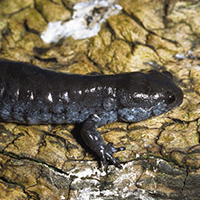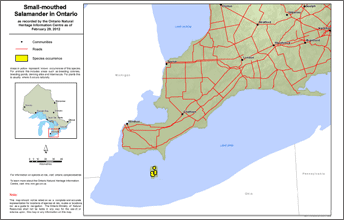Small-mouthed salamander
Scientific name: Ambystoma texanum

Cover photo credit: Allen Woodliffe
Status
Endangered
“Endangered” means the species lives in the wild in Ontario but is facing imminent extinction or extirpation.
Date added to the Species at Risk in Ontario List
February 2, 2009
What it looks like
The Small-mouthed salamander is a medium-sized, dark-bodied salamander with pale gray patches on its tail and sides that resemble lichen. It can grow to a maximum length of 17.8 centimetres. As its name suggests, it has a relatively small head and a short, narrow snout.
This secretive salamander belongs to the “mole salamander” family, which is so called because adults spend the non-breeding season in burrows underground.
Where it lives
The Small-mouthed salamander prefers moist habitats, such as tall grass prairies, dense deciduous forests and agricultural lands that provide suitable breeding ponds. They require soft soil for digging burrows and ponds without fish for breeding.
Eggs are laid on leaf litter and debris at the bottom of the pond. It is important that the ponds do not support fish because these predators would eat the young salamanders.
Adults spend most of the non-breeding season hidden in burrows dug by themselves or by other animals, underneath decomposing tree trunks, rocks or fallen leaves.
Where it’s been found in Ontario
In Canada, the Small-mouthed salamander is found only on Pelee Island in extreme southwestern Ontario. This species was considered locally abundant in 1991, but by 2000 the range of this salamander decreased substantially, when two out of only five known breeding ponds dried up. There are currently no population estimates for the Small-mouthed Salamander on Pelee Island.
View a larger version of this map (PDF)
What threatens it
The most significant threat to the Small-mouthed salamander is habitat degradation. Threats include reduction in forest cover that slows the evaporation of breeding ponds, removal of decomposing logs that provide habitats for invertebrates on which salamanders feed, and decreased water levels.
Water levels are particularly important since sufficient water is needed in the breeding pond to allow tadpoles to mature (particularly from March to July).
The Small-mouthed Salamander can also produce hybrids by breeding with the more common Blue-spotted Salamander. The hybrid population may increase competition for resources.
Action we are taking
Endangered Species and their general habitat are automatically protected.
Recovery strategy
A recovery strategy advises the ministry on ways to ensure healthy numbers of the species return to Ontario.
Read the executive summary (May 30, 2018)
Read the recovery strategy (May 30, 2018)
Read the previous recovery strategy (March 2, 2015)
Government response statement
A government response statement outlines the actions the government intends to take or support to help recover the species.
Read the government response statement (February 28, 2019)
Review of progress
A review of progress made toward protecting and recovering a species is required no later than the time specified in the species’ government response statement, or not later than five years after the government response statement is published if no time is specified.
Read the report on progress towards the protection and recovery of 12 species at risk, including Small-mouthed salamander (2022).
Habitat protection
General habitat protection - June 30, 2013
What you can do
Report a sighting
- Report a sighting of an endangered animal or plant to the Natural Heritage Information Centre. Photographs with specific locations or mapping coordinates are always helpful.
- The Ontario Reptile and Amphibian Atlas also collects observations of all Ontario reptiles and amphibians. Submit your observations to either of these databases.
Volunteer
Volunteer with your local nature club or provincial park to participate in surveys or stewardship work focused on species at risk.
Be a good steward
- Private land owners have a very important role to play in species recovery; if you find Small-mouthed salamander on your land, you may be eligible for stewardship programs that support the protection and recovery of species at risk and their habitats.
- As with all wildlife, be respectful and observe from a distance; please do not try to catch wild salamanders; bug repellant and oils on human hands may damage the delicate skin of these little amphibians.
- Every year salamanders all over the province must cross busy roads; road mortality is a serious threat for many of Ontario’s amphibians; watch for salamanders and other amphibians on the roads, especially between April and June.
Report illegal activity
Report any illegal activity related to plants and wildlife to
Quick facts
- In Greek, the word "amphibian” means “two lives” and refers to the aquatic tadpole and the terrestrial adult stages of all amphibians; salamander tadpoles hatch from eggs laid in the water and transform into adults (through a process called metamorphosis) by developing legs and lungs that allow it to move out of the water and onto land
- Salamanders can take in oxygen through their highly permeable skin; their skin can also easily absorb pollutants and other toxins, which can cause serious harm or death
- Although populations of many plants and animals have been declining worldwide, amphibians are experiencing an especially dramatic decline; the loss of these sensitive creatures may act as a warning that our own environment is being dangerously altered and polluted
